Sign up for the Starts With a Bang newsletter
Travel the universe with Dr. Ethan Siegel as he answers the biggest questions of all.
Out there in the Universe, black holes abound.
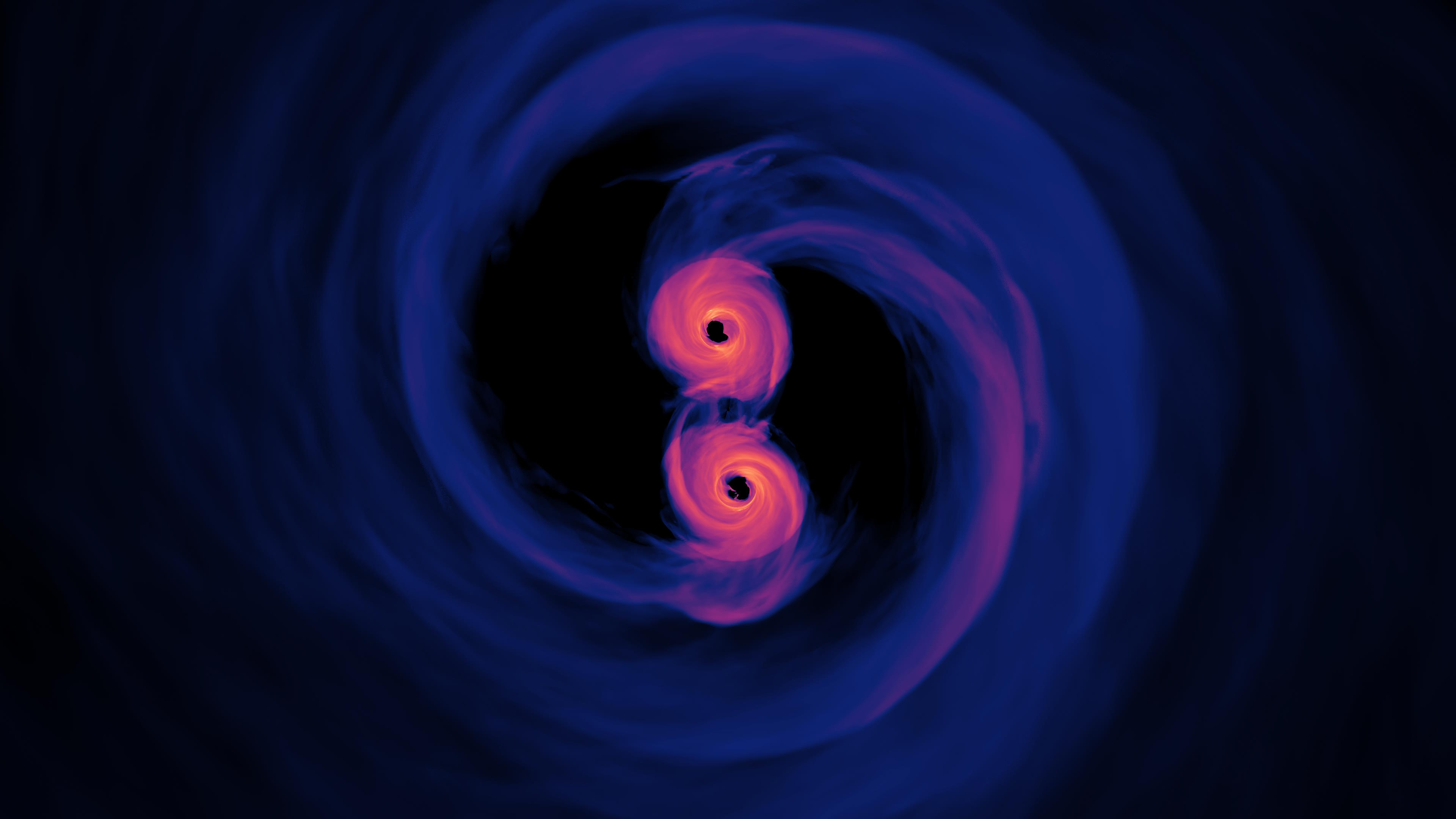
When two black holes merge, a significant portion of their mass can get converted into energy, in the form of gravitational waves, in one very short time interval. Over a much longer period of time, there’s an earlier stage where these black holes orbit with periods of 1-10 years, and pulsar timing can be sensitive to the cumulative effects of those systems throughout the cosmos. Different types of detectors are needed to observe gravitational waves produced by sources of various masses.
Credit: NASA’s Goddard Space Flight Center
Most are relatively low-mass: just a few solar masses.

When the two arms of an optical interferometer are of exactly equal length and there is no gravitational wave passing through, the signal is null and the interference pattern is constant. As the arm lengths change, the signal is real and oscillatory, and the interference pattern changes with time in a predictable fashion. This technique is what is used to directly reveal the presence of gravitational waves.
However, supermassive varieties, at millions or billions of solar masses, exist within galaxies.
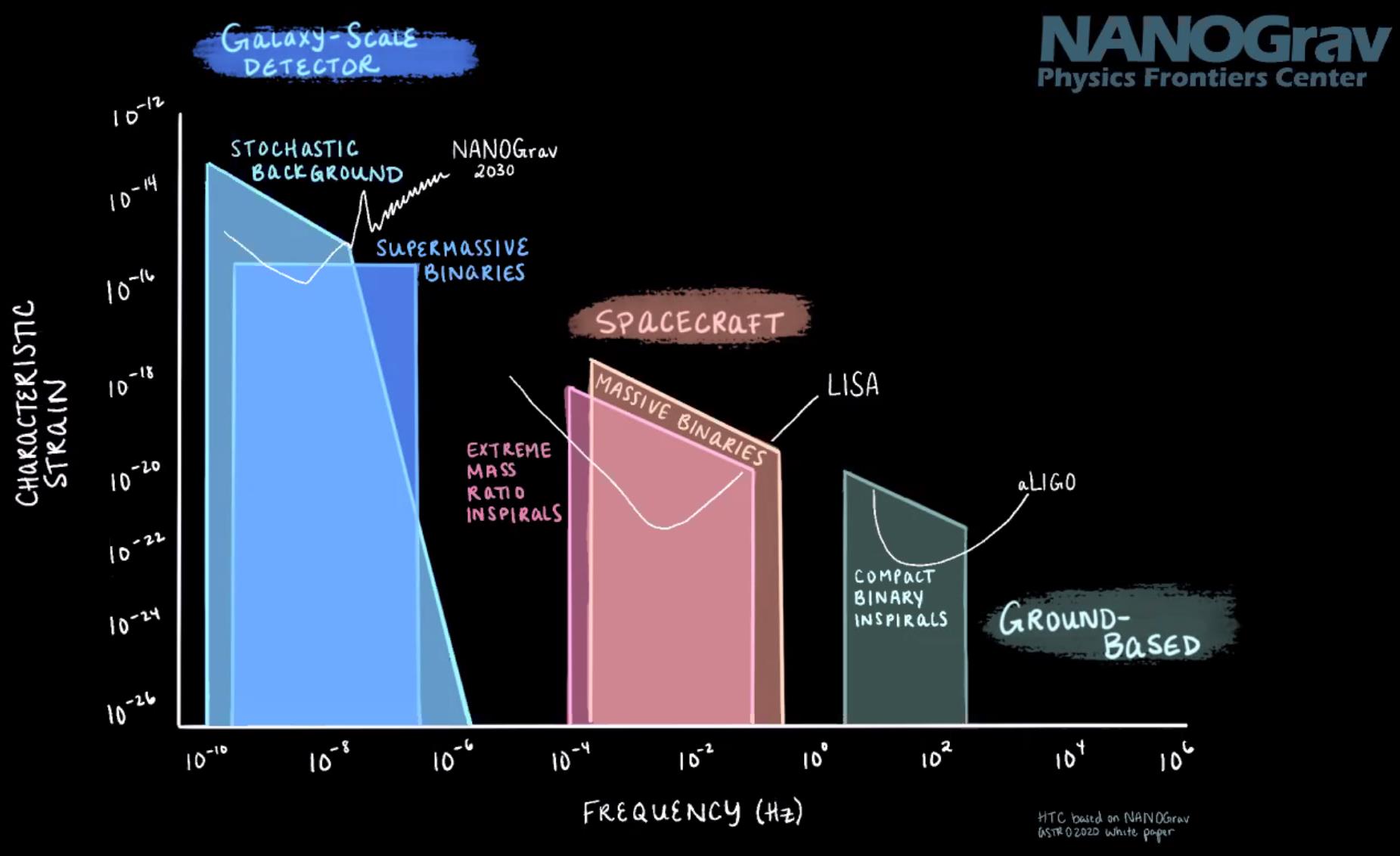
The three different sets of approaches to gravitational waves, ground-based laser interferometers, space-based laser interferometers, and pulsar timing arrays, are all sensitive to different classes of gravitational wave signals. While LIGO was the first collaboration to detect gravitational waves at very high frequencies, the NANOGrav collaboration sees strong evidence at very low (nanohertz) frequencies. Pulsar timing is one of the best methods for probing the longest-wavelength gravitational waves of all, produced primarily by the heaviest orbiting supermassive black hole pairs.
Too massive for LIGO to see, they require longer-baseline gravitational wave detectors.

The image above shows an illustration of the three future LISA, or Laser Interferometer Space Antennae, spacecraft, in a trailing orbit behind the Earth. LISA will be our first space-based gravitational wave detector, sensitive to objects thousands of times as massive as the ones LIGO can detect. An array of LISA detectors set up at various points in Earth orbit would be able to detect even merging supermassive black holes: a proposal known as Big Bang Observer.
Credit: University of Florida/NASA
LISA, the proposed Big Bang Observer, or pulsar timing arrays could observe them directly.

This illustration shows how many pulsars monitored in a timing array could detect a gravitational wave signal as spacetime is perturbed by the waves. The longest-wavelength gravitational waves, such as the ones produced by the most massive pairs of merging black holes, are only detectable by methods leveraging extremely long baselines, such as pulsar timing arrays. In a similar fashion, a precise enough laser array could, in principle, detect the quantum nature of gravitational waves.
Credit: D. Champion/MPIFR
Galactic mergers bring multiple supermassive black holes together, leading to inspirals, mergers, and ringdowns.

The messy cores of these colliding galaxies hide the final stage of two merging galactic nuclei. The right-hand images for these five galaxies show close-ups in infrared light of the galactic cores, which clearly show the presence of two separate black holes. Over enough time, these black holes will all merge together, where the final stages of the merger will be due to the emission of gravitational waves until their event horizons contact one another, leading to a merger and ringdown.
Credit: NASA, ESA, and M. Koss (Eureka Scientific, Inc.); Hubble image: NASA, ESA, and M. Koss (Eureka Scientific, Inc.); Keck images: W. M. Keck Observatory and M. Koss (Eureka Scientific, Inc.); Pan-STARRS images: Panoramic Survey Telescope and Rapid Response System and M. Koss (Eureka Scientific, Inc.)
The heaviest binary supermassive black hole is OJ 287, discovered in 1887.
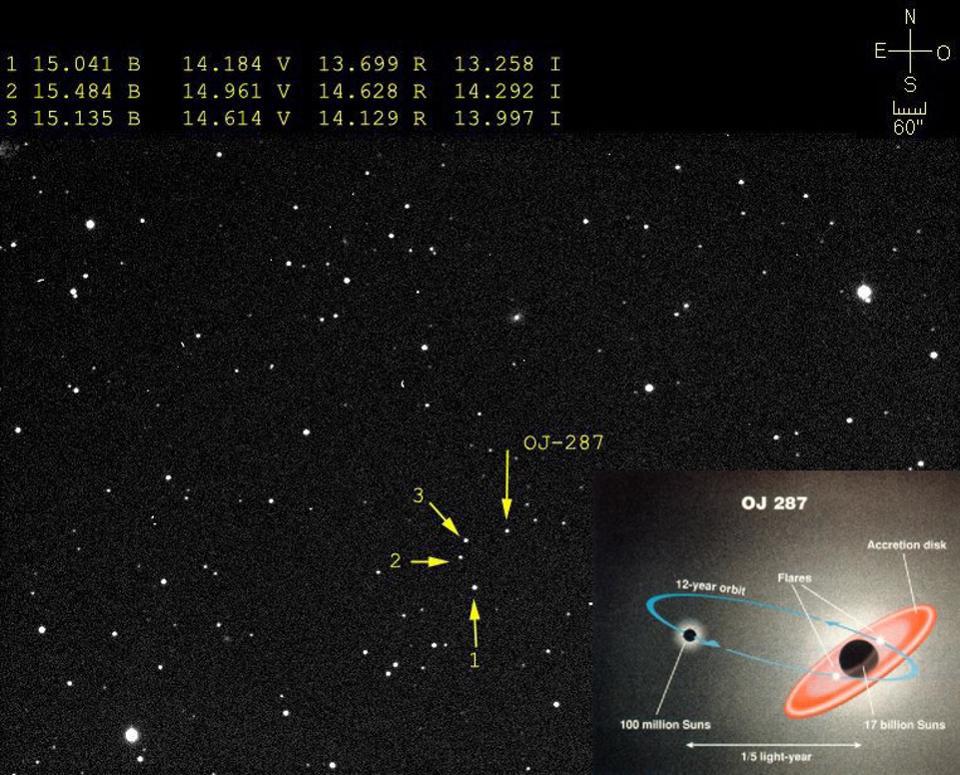
The most massive pair of black holes in the known Universe is OJ 287, whose gravitational waves will be so long in wavelength that they’ll even be out of reach of LISA. A longer-baseline gravitational wave observatory could see it, as could, potentially, a sufficiently precise pulsar timing array. Although OJ 287 was first imaged in 1887, its nature and distance were not determined until the 1960s.
Located ~4 billion light-years away, black holes of 150 million and ~18 billion solar masses orbit one another.

This diagram shows the relative sizes of the event horizons of the two supermassive black holes orbiting one another in the OJ 287 system. The larger one, of ~18 billion solar masses, is 12 times the size of Neptune’s orbit; the smaller, of 150 million solar masses, is about the size of the asteroid Ceres’s orbit around the Sun. The heaviest known black hole is only a few times more massive (and hence, a few times larger in radius) than OJ 287’s primary.
Every 11-12 years, they complete one orbit.

The double peaks of the flare seen from OJ 287 is consistent with the smaller black hole punching through the larger’s accretion disk twice per orbit. The rate of the flaring, plus time-based changes in the flare’s orientation, are thoroughly predictable with Einstein’s general relativity alone.
Due to general relativity, their orbits precess substantially: by 39° per revolution.
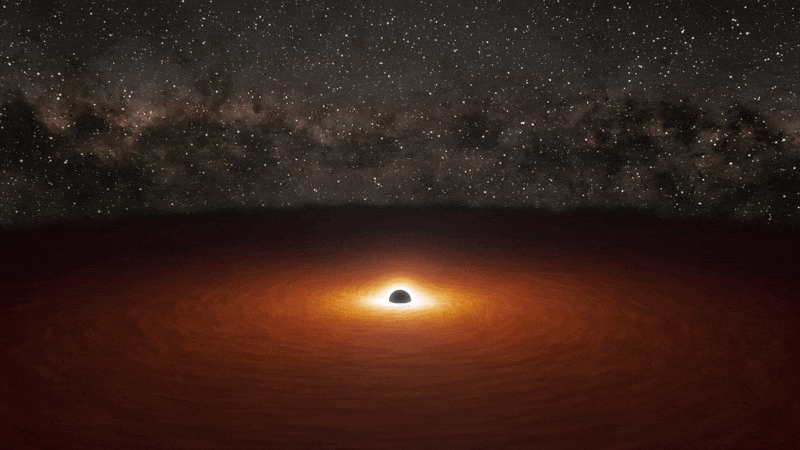
This animation shows a lower-mass black hole punching through the accretion disk generated around a larger supermassive black hole. When the smaller black hole crosses through the disk, a flare emerges. Over long enough timescales, these black holes will inspiral and merge, generating a tremendous gravitational wave signal in the process. This bursting “double flare” system is a prominent characteristic of OJ 287.
Flaring bursts arise as the low-mass one punches through the larger’s accretion disk.

A close-up (left) and wider-field (right) view of the central nucleus of the nearby galaxy NGC 7727. Just 89 million light-years away, it houses the closest pair of binary supermassive black holes known, with a separation of 1,600 light-years. While friction with the environment can lead supermassive black holes to closely approach one another, the final stages of an inspiral and merger should come due to gravitational wave emission. Binary supermassive black holes are fairly common at the centers of galaxies, representing about 1-in-1000 galactic systems.
This “double quasar” isn’t unique, representing about 0.1% of all quasars.

When two supermassive black holes orbit one another, they not only perturb and accelerate the matter surrounding them, they leave definitive signatures in the emitted electromagnetic radiation that is complementary to the gravitational wave radiation, offering another avenue for direct detection and a way to independently confirm the black holes’ masses. Although this shows the radio data for binary black hole system 3C 344, the physics is very similar for the analogous OJ 287.
The space-based RadioAstron, combined with ground-based telescopes, enables VLBI: very long baseline interferometry.

In very-long baseline interferometry (VLBI), the radio signals are recorded at each of the individual telescopes before being shipped to a central location. Each data point that’s received is stamped with an extremely accurate, high-frequency atomic clock alongside the data in order to help scientists get the synchronization of the observations correct. The longer the separation between individual telescopes, the higher the maximum achievable resolution becomes.
Credit: public domain/Rnt20 at English Wikipedia
This achieves our highest-ever resolution observations.
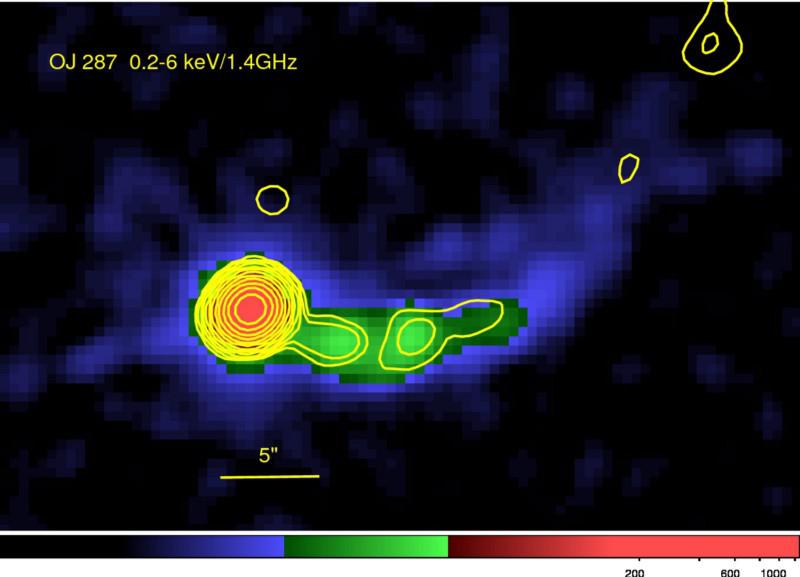
An X-ray and radio composite of OJ 287 during one of its flaring phases. The ‘orbital trail’ that you see in both views is a hint of the secondary black hole’s motion. This system is a binary supermassive system, where one component is approximately 18 billion solar masses and the other is 150 million solar masses. When they merge, they may emit as much energy, albeit in the form of gravitational waves, as was found in the most energetically-injected galaxy cluster.
A long ribbon-like radio jet was just discovered: enhancing our view of OJ 287.

This novel observation, taken with the space-based RadioAstron telescope in conjunction with a 27-element ground based array, provides ~15 micro-arc-second resolution of the distant black hole binary OJ 287. This ribbon-like radio jet reveals temperatures exceeding 10^13 K, with the ribbon’s shape indicating strong magnetic fields near the heavier of the two orbiting supermassive black holes.
In ~10,000 years, these black holes will merge.
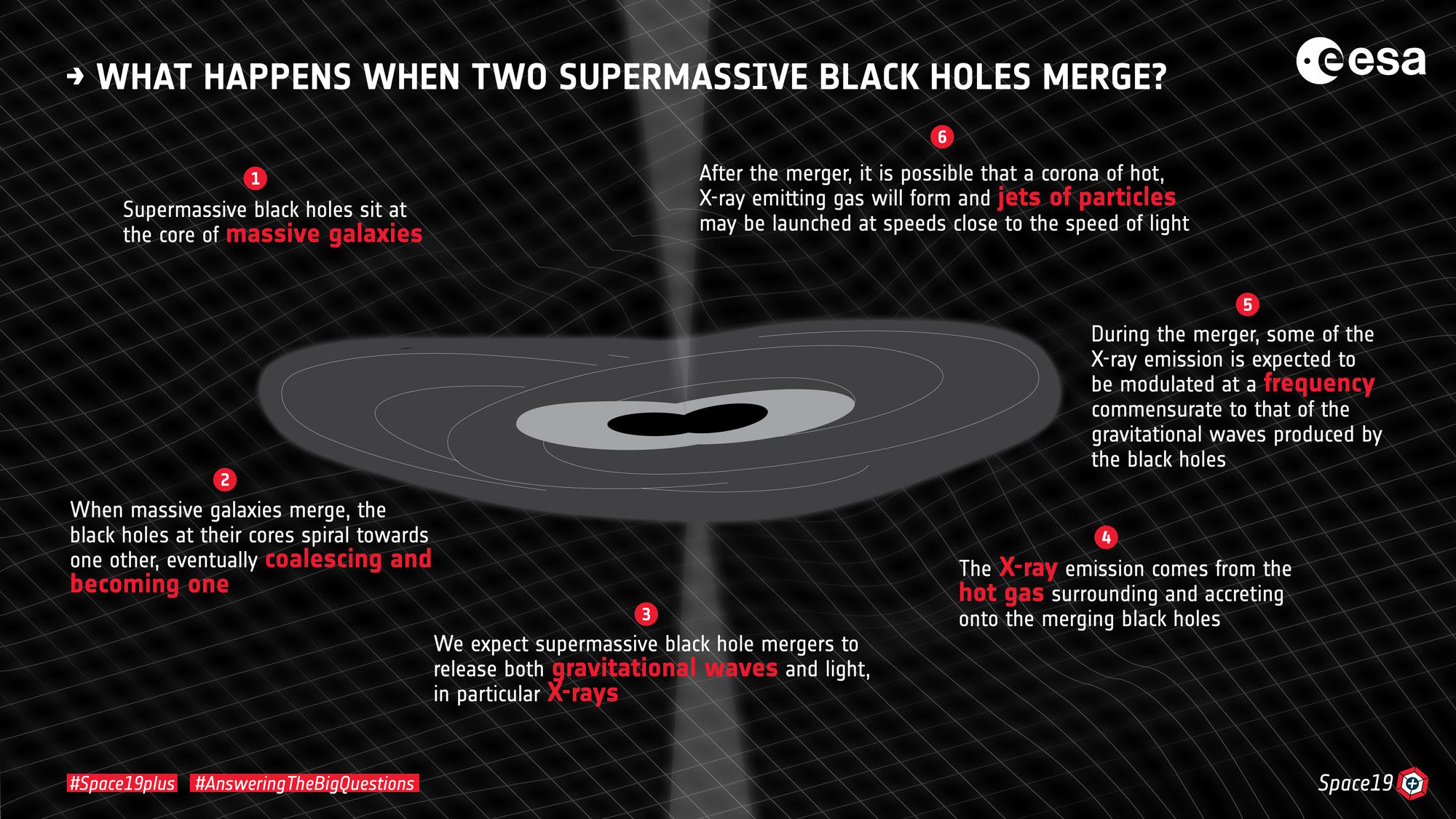
This illustration maps out the various stages of a supermassive black hole merger, and the expected signals that scientists believe will emerge as the event unfolds. Once the two pre-merger black holes pass within the same event horizon, no further gravitational waves get emitted, save for the “ringdown” phase due to the changing shape of the post-merger event horizon.
The merger will release 3 × 1054 J of gravitational wave energy: an inevitable, record-breaking event.
Mostly Mute Monday tells an astronomical story in images, visuals, and no more than 200 words.
Sign up for the Starts With a Bang newsletter
Travel the universe with Dr. Ethan Siegel as he answers the biggest questions of all.
Source link


